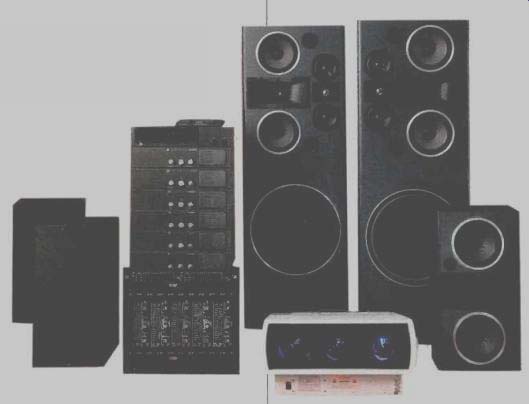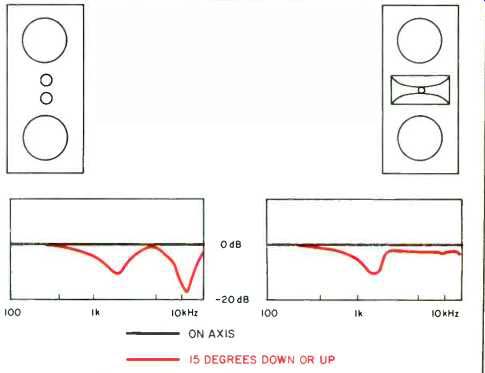SYNERGISTIC SYSTEM
Few audio companies have been able to attain synergy between their consumer and professional divisions, and certainly no company has done it longer than JBL. From its formation in 1946, the company has offered loudspeakers for the home as well as for a wide array of professional applications, and about a decade ago JBL theater systems provided the hardware basis of THX systems for the motion picture industry. It has been a decade of overall improvement in theater sound-and also for home video by way of a new set of consumer system standards drafted by THX.

------ JBL's Synthesis One has one set of speakers for home theater
and another for music.
Most companies who have THX licenses for home video sound have opted for traditional high-fidelity componentry as their basis for developing loudspeakers for that application.
When JBL began its home video pro gram about a year and a half ago, the company took the approach of adapting traditional theater hardware to the home environment, and the first of a new group of systems was formally shown to the industry at the Summer Consumer Electronics Show this past May. This system, Synthesis One, sets the fundamental direction for what JBL intends to accomplish in the field. What is truly noteworthy about the system is its price--about $40,000--and the fact that it is virtually two systems in one-a horn system for video, and a traditional cone and dome system for normal stereo listening.
In the theater mode, the left and right channels each consists of an 18-inch subwoofer, which makes a transition into a pair of vertically arrayed 8-inch cone drivers. Between these two drivers is a Bi-Radial horn with nominal coverage angles of 40° in the vertical plane and 90° in the horizontal plane.
This is the preferred coverage in the theater, and it is matched pretty well by the vertical spacing of the 8-inch cones. The center channel, placed be low the screen, consists of just the 8-inch pair and the horn. Thus all three "screen channels" are matched in both spectral and directional characteristics. The left and right surround speakers are dipoles, and, as such, contribute to diffuse acoustical power in the listening space, which predominates over their direct sound at the listening position. Electrically, the systems are biamplified, and detailed third-octave equalization is used to match the entire system to a given listening environment.
In the music mode, the system reverts to only the left and right units. The horn is switched out and replaced by a pair of 5-inch cones and a 1-inch dome tweeter.
I recently discussed details of Synthesis One with Eli Harari, a former high-end audio/video dealer now on JBL's staff, who co-developed the system with engineer Dan Sieffert. Our conversation follows.
Why two systems in one?
In the motion picture industry, music, dialog, and sound effects are mixed over horn speakers and played back over identical systems in theaters. For the most part, music mixes [standard recordings] are made over near-field monitors that aren't too different from what most consumers have at home.
Theater speakers are directional and don't stir up much reverberation. Even in the living room this can be used to advantage in creating a sonic trait that matches the "close-in" nature of video presentation. For music, most of us want a more diffuse sound, which is what cones and domes will provide.
In what other ways does Synthesis One differ from the usual THX home approach?
There are two aspects here. JBL will set standards for system setup and provide actual measurement specs for dealers using state-of-the-art testing methods. We realize that most of these systems will be installed in large spaces. Synthesis One was designed for rooms up to 22,000 cubic feet, which is two to three times the room size most home THX systems are capable of handling.
What about the stratospheric price of Synthesis One, and what will be the next products in the line?
When you do a no-holds-barred product you shoot for the very best, and this is what we are delivering. We intend to produce two more systems of the same general type, one priced at about $25,000 and another at about $15,000. All three systems will incorporate the dual approach used in System One, with horns for cinema and direct radiators for music.
There has been much discussion of surround loudspeakers. How do you compare the THX pair of dipole speakers, which JBL uses here, with the traditional JBL theater approach, which uses up to 12 standard speakers for surround?
The film producer's use of surround channels is to further envelop the audience in the film experience. You are not expected to turn your head and focus in on a surround loudspeaker. In the movie theater, this calls for many speakers, all operating at a low level so that all patrons get the right sensation. In the home, the viewing position is fairly restricted. This lets us use a single pair of speakers, one on each side. These have dipole radiation pat terns that tend to project the sound strongly to the front and back of the room, creating a pattern of reflected, non-localizable sound at the listening position.
The Synthesis One system easily out classes the systems in most video post-production houses where films are routinely processed to VCR and LaserDiscs. Can you comment on this for me please?
Gladly. We are beginning to get re quests-and orders-from post-production houses, and this seems to be driven by an interest in THX requirements in the field. Their concern is basically that Synthesis One is better than the standard systems in their dubbing rooms, and many people in that business would like to make it their reference system.
With JBL's tradition of high efficiency, is bi-amplification really necessary in the home environment?
First of all, this system was not designed to meet necessity, but to advance the state of the art. Today, most soundtracks are very wide range and are intended to be played back at high levels. Bi-amplification assures us that the system will handle it all in stride. Another point should be mentioned: There is no "need" for two subwoofers. However, they do help us overcome certain low-frequency, room-mode problems-and the object was, and still is, ultimate home performance. I think I can sum this up quite well by saying that this is not just a home-theater system; it is a theater system for the home.
What future improvements do you see in Synthesis One?
We are looking into many areas, and the two that we are most focused on at this time are equalization and dividing networks. We would like to replace their analog circuitry with digital, and of course we intend to introduce digital technology into all phases of system control.
How are your marketing plans being shaped by the lingering recession?
System One is relatively recession-proof because it makes such a powerful technological statement. I am more concerned that if the recession lingers through 1993, System Two, and to an even greater extent System Three, will be impacted. At the same time, even if the market shrinks I believe we will be successful, just because our product is the best in the market.
-----------
Why Horns Are More Effective than Direct Radiators in the Theater
Direct radiators can be stacked vertically to produce a narrow, vertical radiation pattern. There is a penalty here, and that is the inevitable dip in off-axis vertical response. With a pair of midrange drivers and a pair of tweeters there will be two such dips (Fig. B1).
When a high-frequency horn is used, its inherent directional control will give the desired radiation pattern with smooth off-axis response. In the case shown here, the midrange cones still produce their response dip. The trade off here is one of size. A large horn, such as would be used in the theater, covers the range from 500 Hz up to 12.5 kHz with very smooth off-axis response, but it is about 3 feet long! In adapting horn technology for the home, the Synthesis One uses it above 1,200 Hz, letting direct radiators cover the range from there down to about 125 Hz. The single off-axis dip is an acceptable consequence of this size constraint.

-------- Fig. B1--Stacked drivers (left) control vertical dispersion
but create response dips above or below axis. Using a horn rather than
stacked tweeters to control treble dispersion (right) eliminates the upper-frequency
dip.
(adapted from Audio magazine, Sept. 1992)
= = = =